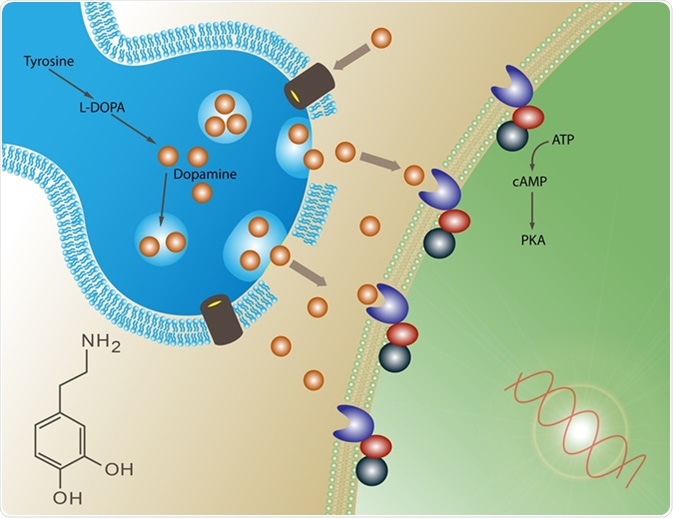Dopamine is a neurotransmitter released by the brain that plays a number of roles in humans and other animals. Some of its notable functions are in:
- movement
- memory
- pleasurable reward
- behavior and cognition
- attention
- inhibition of prolactin production
- sleep
- mood
- learning

Dopamine. Image Credit: Meletios / Shutterstock
Excess and deficiency of this vital chemical is the cause of several disease conditions. Parkinson's disease and drug addiction are some of the examples of problems associated with abnormal dopamine levels.
Where is dopamine produced?
Dopamine is produced in the dopaminergic neurons in the ventral tegmental area (VTA) of the midbrain, the substantia nigra pars compacta, and the arcuate nucleus of the hypothalamus.
Dopamine in movement
A part of the brain called the basal ganglia regulates movement. Basal ganglia in turn depend on a certain amount of dopamine to function at peak efficiency. The action of dopamine occurs via dopamine receptors, D1-5.
Dopamine reduces the influence of the indirect pathway, and increases the actions of the direct pathway within the basal ganglia. When there is a deficiency in dopamine in the brain, movements may become delayed and uncoordinated. On the flip side, if there is an excess of dopamine, the brain causes the body to make unnecessary movements, such as repetitive tics.
Dopamine in pleasure reward seeking behavior
Dopamine is the chemical that mediates pleasure in the brain. It is released during pleasurable situations and stimulates one to seek out the pleasurable activity or occupation. This means food, sex, and several drugs of abuse are also stimulants of dopamine release in the brain, particularly in areas such as the nucleus accumbens and prefrontal cortex.
Dopamine and addiction
Cocaine and amphetamines inhibit the re-uptake of dopamine. Cocaine is a dopamine transporter blocker that competitively inhibits dopamine uptake to increase the presence of dopamine.
Amphetamine increases the concentration of dopamine in the synaptic gap, but by a different mechanism. Amphetamines are similar in structure to dopamine, and so can enter the presynaptic neuron via its dopamine transporters. By entering, amphetamines force dopamine molecules out of their storage vesicles. By increasing presence of dopamine both these lead to increased pleasurable feelings and addiction.
Dopamine in memory
Levels of dopamine in the brain, especially the prefrontal cortex, help in improved working memory. However, this is a delicate balance and as levels increase or decrease to abnormal levels, memory suffers.
Dopamine in attention
Dopamine helps in focus and attention. Vision helps a dopamine response in the brain and this in turn helps one to focus and direct their attention. Dopamine may be responsible for determining what stays in the short term memory based on an imagined response to certain information. Reduced dopamine concentrations in the prefrontal cortex are thought to contribute to attention deficit disorder.
Dopamine in cognition
Dopamine in the frontal lobes of the brain controls the flow of information from other areas of the brain. Disorders of dopamine in this region lead to decline in neurocognitive functions, especially memory, attention, and problem-solving.
D1 receptors and D4 receptors are responsible for the cognitive-enhancing effects of dopamine. Some of the antipsychotic medications used in conditions like schizophrenia act as dopamine antagonists. Older, so-called "typical" antipsychotics most commonly act on D2 receptors, while the atypical drugs also act on D1, D3 and D4 receptors.
Regulating prolactin secretion
Dopamine is the main neuroendocrine inhibitor of the secretion of prolactin from the anterior pituitary gland. Dopamine produced by neurons in the arcuate nucleus of the hypothalamus is released in the hypothalamo-hypophysial blood vessels of the median eminence, which supply the pituitary gland. This acts on the lactotrope cells that produce prolactin. These cells can produce prolactin in absence of dopamine. Dopamine is occasionally called prolactin-inhibiting factor (PIF), prolactin-inhibiting hormone(PIH), or prolactostatin.
Social functioning
Low D2 receptor-binding is found in people with social anxiety or social phobia. Some features of negative schizophrenia (social withdrawal, apathy, anhedonia) are thought to be related to a low dopaminergic state in certain areas of the brain.
On the other hand those with bipolar disorder in manic states become hypersocial, as well as hypersexual. This is credited to an increase in dopamine. Mania can be reduced by dopamine-blocking anti-psychotics.
Dopamine levels and psychosis
Abnormally high dopaminergic transmission has been linked to psychosis and schizophrenia. Both the typical and the atypical antipsychotics work largely by inhibiting dopamine at the receptor level.
Pain processing
Dopamine plays a role in pain processing in multiple levels of the central nervous system. This includes the spinal cord, periaqueductal gray (PAG), thalamus, basal ganglia, insular cortex, and cingulate cortex. Low levels of dopamine are associated with painful symptoms that frequently occur in Parkinson's disease.
Dopamine in nausea and vomiting
Dopamine is one of the neurotransmitters implicated in the control of nausea and vomiting via interactions in the chemoreceptor trigger zone. Metoclopramide is a D2-receptor antagonist and prevents nausea and vomiting.
Further Reading